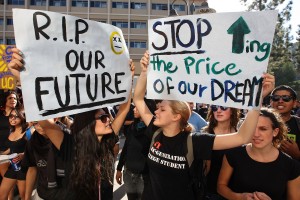Universities May Be Pushing Private Loans In Spite Of Government Concerns

Photo by David McNew/Getty Images
University of California Los Angeles (UCLA) students and supporters protest as the UC Board of Regents meets to vote on a 32 percent tuition hike.
A new report released by the Federal Center for Education Statistics raises concerns about the rate at which college students are turning to private loans to finance their high education. According to the study, the percentage of students taking out private debt has increased by nine percent since 2003, compared to three percent or less for government and government subsidized loans.
The largest percentage of increase comes from students attending for-profit institutions like University of Phoenix. Among students attending these schools, private borrowing increased by 29 percent.
According to a report from investment advisors at Morningstar, a rough economy has eroded many of the benefits long associated with student debt, making these types of liabilities more difficult to manage.
Not only may student-loan terms be less attractive than they were in the past–particularly for those who need to go to the private market to secure one–but new grads may also get squeezed if they have to begin repaying their loans before they land a job.
The FCES report concludes it is often the financial aid officers at universities who are pushing students in the direction of private lenders.
The Wall Street Journal’s Smart Money published an article detailing a number of ways of avoiding overwhelming student debt. It points to many common practices among financial aid officers which may actually be making things more difficult for students. For example, the article recommends avoiding cosigners when taking out debt.
Private lenders often tout the benefit of an adult cosigner, saying that because students don’t have much of a credit history, the a co-signer’s good standing can help secure a lower interest rate. That’s true, but it also puts the student at the mercy of the parent’s credit history, which may not be so stable these days.
According to the FCES report, undergraduates accounted for the largest increase in student borrowing, followed by graduate students. Borrowing among doctoral candidates has not increased significantly since 2003.
